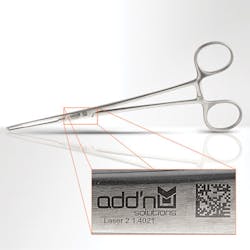Tests on surgical instruments demonstrate UDI laser marking durability
TUTTLINGEN AND SELMSDORF, GERMANY – Add'n Solutions, which provides Unique Device Identification (UDI) laser marking on medical devices, worked in close cooperation with FOBA Laser Marking + Engraving to conduct a long-term study on reusable surgical instruments, with the aim of proving that laser marks remain clearly readable despite multiple reprocessing procedures. The UDI must resist increased wear throughout the whole product life cycle to ensure safe traceability, which is also officially required.
The comprehensively documented study demonstrated that laser-marked, high-contrast UDI codes can resist at least 500 sterilization and cleaning cycles. FOBA's short-pulse fiber marking lasers optimally adapt to the surface characteristics of different types of stainless steel, with appropriate laser parameters to prevent the inscription from fading out or corroding. An additional passivation ensures that the complete device, including marked areas, is protected against corrosion. The ASTM 967 standard for stainless steel passivation was used for passivation of the instruments.
In the study, Add'n Solutions used a precisely matched laser marking process, followed by a cleaning and passivation cycle. The surgical instruments were then sterilized and cleaned 500 times, simulating actual wear conditions in a hospital. The steam sterilization was accompanied by an instrument cleaning with high-alkaline cleaners (pH value 14), which is also equivalent to clinical cleaning procedures.
A direct mark on a medical product must be of high contrast and resistance and also not have a negative impact on surface quality. Until recently, it was unknown how often laser-marked surgical instruments can be reprocessed without negatively impacting the quality of the mark.
Notwithstanding the type of laser used (short- or ultrashort-pulse laser), the recent study provided evidence that only an additional passivation developed to exactly match the marking process creates appropriate long-term protection against corrosion, ensuring readability of the marks.
The present study suggests the assumption that marking with an ultrashort-pulse laser does not require passivation is incorrect—only accompanied by a passivation process can the complete product be reliably protected.
The latest legal regulations of the U.S. Food and Drug Administration (FDA) and the European Medical Device Regulation require that all medical products must bear UDI marks, with implementation deadlines that vary according to the risk class of the device.
An application case study with a detailed description of the durability test on reusable surgical instruments is available for free download at www.fobalaser.com.
For more information about Add'n Solutions, please visit www.addn-solutions.de/en.

